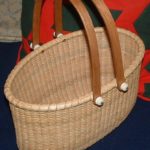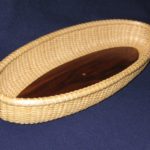Evolution | Materials | Why Me? | Classes & Exhibits | Styles, Sizes, & Prices | Order
Nantucket Lightship Baskets: What are they?
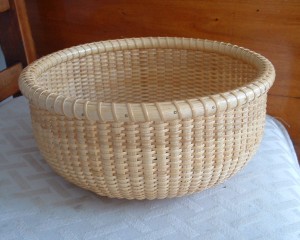 From the seventeenth century, basket making was one of the many skills that the Wampanoag natives taught Nantucket’s new settlers. Over the years, Island’s new weavers added features, such as grooved wood bottoms and firm rims, to increase their durability. When Nantucket whaling captains traveled to the South Seas, they were introduced to rattan, which the ships brought home for Nantucket basketmakers to use.
From the seventeenth century, basket making was one of the many skills that the Wampanoag natives taught Nantucket’s new settlers. Over the years, Island’s new weavers added features, such as grooved wood bottoms and firm rims, to increase their durability. When Nantucket whaling captains traveled to the South Seas, they were introduced to rattan, which the ships brought home for Nantucket basketmakers to use.
In 1856, the New South Shoal Lightship, a 103 foot two-masted schooner, was anchored 24 miles south of Sankaty Light, warning commerce away from the shoal.. The men who manned the ship had little to do but clean the lamps and stand watch. Life was difficult, but spare time was plentiful, and from captains on down, they created what is known today as the Nantucket Lightship Basket. These baskets were woven over wooden molds, often made from ships’ masts. One of the principal innovators was veteran Captain Charles B. Ray (1798-1884), who produced the first woven-lidded purse. He was one of numerous artisans, a group which included his son, Captain Charles F. Ray. Lightship baskets were brought ashore on monthly shift-changes and sold for extra income.
Around the end of the 19th century, the Lightship Authority recognized that their employees were “moonlighting” on company time, and they forbade the manufacture aboard the ships. The enterprise moved ashore, but the number of practitioners dwindled. After the 1930’s, barely one person was left: Clinton Mitchel “Mitchie” Ray (1877-1956), son and grandson of the famous Captains.
Evolution: The Friendship Basket, today’s signature pocketbook
 José Formoso Reyes (1902-1980) was born in the Philippines, where he was taught to weave baskets by his father. He found his way to the US and attended high school and Reed College in Oregon. There he met Nantucket-born Mary Elizabeth Ham. He and Betty headed east, where he attended Harvard and she attended nursing school. They were married after graduation and moved to the Philippines. José taught Art and English at the University, and they raised three children. He joined the U.S. Army in 1941 and served as adjutant to the general through the 1945 Philippine Liberation. Returning to the States and earning citizenship, he and Betty moved to Nantucket in 1947 and never left.
José Formoso Reyes (1902-1980) was born in the Philippines, where he was taught to weave baskets by his father. He found his way to the US and attended high school and Reed College in Oregon. There he met Nantucket-born Mary Elizabeth Ham. He and Betty headed east, where he attended Harvard and she attended nursing school. They were married after graduation and moved to the Philippines. José taught Art and English at the University, and they raised three children. He joined the U.S. Army in 1941 and served as adjutant to the general through the 1945 Philippine Liberation. Returning to the States and earning citizenship, he and Betty moved to Nantucket in 1947 and never left.
Despite his credentials, he was unable to find a teaching job. But he met Mitchie, who inspired him to rekindle the basketweaving spirit of his childhood and carry on the Lightship Basket tradition. From his first effort in 1948, José improved his Island skills under Mitchie’s watchful eye, and he created his now-famous Friendship Basket. He sold them for $50 at first, but at the height of his production, the price increased to $333 and demand was so high that, working 12 hours a day, he was often four or more years behind demand. His son Paul and granddaughter Koren worked arduously in the shop toward the end, and Koren carried on the family tradition for almost a decade.
Today, all old Nantucket Lightship baskets are collector’s items, some valued in the thousands of dollars. Reyes-signed originals rival older antiques and fetch from $3,000 up. (Koren claims that Paul was an even better weaver than José!)
The “Nantucket” is not simply a basket or purse. It is a symbol as bold and sturdy as the vessel it’s named for. It is a usable collector’s item that commands high prices at shops, antique shows or estate sales. New manufacture by qualified craftspeople today – well-made and authentic — earn their own heritage, become family heirlooms passed down from generation to generation – and increase in value as they take on the golden-mahogany hue that comes with age.
Materials
The principal materials in Nantuckets are reed and cane. Reed is a product of rattan, which, for commercial use, is harvested mostly in the jungles of Southeast Asia and Indonesia. The long sections of vine are processed and then cut up into various shapes required for weaving. The word cane actually defines the shape of a growing plant as much as the type of plant it is. Thus, sugar plants or rattan plants or bamboo plants produce canes. Weaving cane is the exterior of rattan, while the reed is the inside of the rattan stalks.
Fine woods—-cherry, walnut, oak, cedar and a host of others-—are used for other basket parts, such a bases and handles. Woods are also used by some weavers for staves and rims.
“Hardware,” including findings for attaching handles, pocketbook closure pins and the like are usually bone or ivory. Decorative elements, such as the plates on the top of pocketbooks, are traditionally ivory. They took essentially two forms: carved shapes such as whales or dolphins, and scrimshawed-engraved plates. Legal ivory is still available, and the art of scrimshaw has not disappeared. A realistic synthetic substitute, called “Eco-Ivory,” is available at a much lower cost.
In short, while the skilled labor is the major investment, the outlay in materials for a fine Nantucket Lightship basket is not meager.
Why Me
I grew up in sailing with my family. Every summer during the 1950’s, we took a long cruise up through Long Island Sound to Martha’s Vineyard and Nantucket. I first rounded Brant Point Lighthouse into Nantucket Harbor in 1952. Just fourteen, the mystique of the Island and its whaling heritage fascinated me then and persisted through many return visits. But something else caught my eye from the start –Nantucket’s hallmark “Lightship Basket.” I never forgot this fantasy; even though I later lived in the shadow of Nantucket for 20 years. But I didn’t take up the craft until 2004, after my retirement, when I apprenticed with Guild-trained artisan Bob Moore and just kept going. Now, after fifty years “at sea,” I travel by RV with Dot and our Schips all over the US, making baskets and teaching whenever the opportunity arises.
I never realized until recently that José was in the earliest days of his career when I first sailed to the Island. Oh, if I’d only met him — and purchased several then!
I focus on classic baskets, and the most important thing I can say about them is that they are authentic. While many baskets today are manufactured overseas, often by machine, the true value of a “Nantucket” comes from the painstaking labor and cameo uniqueness of each item hand-produced.
Classes & Exhibits

I taught Nantucket Lightship Basket Weaving annually at the prestigious John C. Campbell School of Folk Art in Brasstown, North Carolina, retiring in 2016 for health reasons. Many students were beginners, with little or no basketmaking experience. Others are basketmakers of other styles and want to add Lightships to their repertoire. More than two thirds of my students purchased molds and materials to continue. My course continues at the School in good hands; sign on to www.folkschool.org.
As a member, I exhibited under the auspices of the Muddy Creek Artists Guild in Maryland and one Best in Category. I continue to teach at my home studio in Florida and at various other venues. For details, please contact me at don@schipperhaven.org.
Styles, Sizes, & Prices
Each basket requires a mold. I have a collection approaching two dozen, which gives me the latitude to produce a wide variety of work. Whether you are interested in a single, short or tall basket, any one of several pocketbooks, a handled “tote,” a unique set of nested baskets, serving trays and bread baskets, square baskets or miniatures, I will be glad to accommodate. I donate 15% of the sales price to Schipperke rescue.
 Round Baskets and Nests
Round Baskets and Nests
I have a set of seven round molds ranging in size from 3” to 12” inches in 1 ½ inch increments. This set provides an opportunity to send you anything from one to a complete nest of round baskets. They can be short or tall. They can have handles or not.
Single round Nantucket Lightship Baskets start at $50.00. Pricing is based on several factors:
- Diameter (3” to 12”)
- Height (Short, approximately 3 inches or Tall, approximately 7 inches)
- Handles–traditionally oak or cherry, though other woods are available. They can be affixed with brass findings or with bone or ivory knobs and washers.
- Material–unless otherwise specified, I use reed staves, cherry bases, reed rims and cherry handles. Wood staves and wood rims are available.
Nests are a bit more expensive than individual baskets, because extra time is involved to assure that they fit together properly. Nests can be any number from two to seven baskets, starting with any size. They traditionally include handles.
Pocketbooks
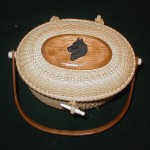 The signature item in the pocketbook line is the Reyes Friendship Basket. It measures approximately 6 x 9 inches and 8 inches high. The hinges and closure are made from leather wrapped in cane. The handle is affixed with bone knobs and washers. The closure is held by an ivory “marlinspike.” Options include the decoration on the top of the pocketbook, and there is a wide variety to choose from, both decorative Nantucket-style plaques and dimensional figures. Most are available in Eco-Ivory at very reasonable prices. Both plaques and the dimensional figures–and original scrimshaw–are available in legal ivory, at considerably higher costs. A personalized bone or ivory nameplate can adorn the inside of the lid. I have several Schipperke options, as shown above, but not other dog breeds.
The signature item in the pocketbook line is the Reyes Friendship Basket. It measures approximately 6 x 9 inches and 8 inches high. The hinges and closure are made from leather wrapped in cane. The handle is affixed with bone knobs and washers. The closure is held by an ivory “marlinspike.” Options include the decoration on the top of the pocketbook, and there is a wide variety to choose from, both decorative Nantucket-style plaques and dimensional figures. Most are available in Eco-Ivory at very reasonable prices. Both plaques and the dimensional figures–and original scrimshaw–are available in legal ivory, at considerably higher costs. A personalized bone or ivory nameplate can adorn the inside of the lid. I have several Schipperke options, as shown above, but not other dog breeds.
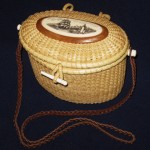
Two other pocketbooks are available. One is the Reyes-styled Evening Bag, similar to the Friendship Basket but slightly smaller (5 x 7 inches) and flatter on one side to hang against the body on a woven leather strap. The other is a conversion of the larger oval Market Basket (below) with the addition of a zippered liner.
Oval Baskets
The Market Basket is a favorite of many. It measures 6 x 12 inches and is 8 inches tall. It has two handles for easy and secure handling. Of course it does just as well with a plant or a bouquet of flowers for table décor. It can also serve as a pocketbook, as discussed above.
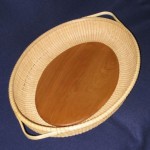
14 x 18 Tray
A 6 x 16 inch Bread Basket is designed to hold French bread or a baguette, though it can serve other uses as well. I was so struck by its lines that I ordered a mold immediately! The 14 x 18 inch Tray, featuring handles on each end, is enhanced by a large, fine wood base. The small Cracker Basket is approximately 8 inches long. Shorter versions of the Friendship or Market baskets are other options.
Order
To order Nantucket Lightship Baskets or Pocketbooks individually hand-crafted by Don, please contact me via email at don@schipperhaven.org. Detail your request, and ask any questions you may have. I’ll work with you to provide final costs and delivery schedule, I’ll confirm and finalize your order by e-mail or by phone if you include your number. You can pay either by check or through our PayPal site. I also carry a supply of equipment and materials with us while we travel, so Nantuckets can be ordered and delivered in a reasonable amount of time. 15% of all sales is contributed to Schipperke Rescue.

